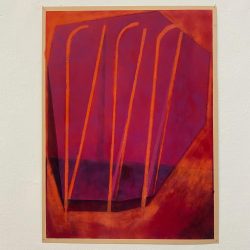The three artists in the exhibition share an interest in different forms of perception and picturing, cognitive processes and scientific thinking. But while Hilda Kozári creates multisensory objects from a wide variety of materials – copper, felt, often using scents – Klára Rudas and Róza El-Hassan’s medium is painting and drawing, both inspired by volumes of scientific diagrams and proof processes.
Commenting on the work of Róza El-Hassan, Lívia Páldi summarises: In the center of the first cycle is the study of the interaction between electromagnetic fields and biological entities intrigued by a book El-Hassan found many years ago in a skip. A. S. Presman’s Electromagnetic Fields and Life was first published in 1970 and reviewed research on the possible effect of a broad region of electromagnetic spectrum on living systems. He contradicted statements that assumed no influence and supported it with measures conducted on migratory birds, fishes, and mosquitoes. His published diagrams, (…) have served as a source of inspiration for El-Hassan to create drawings and objects materializing the invisible power fields and interactions around us. Field strength is captured as organic knots with the intense spiraling and density of lines with cut outs, paint, even smaller objects attached applying concepts of rhizome and assemblage. Her series like intimate mapping of fragile and vulnerable conditions, intense thinking of conflict-affected situations but also of resilience, perseverance and defiance. (..) Complex rhizomatic processes drive the work of the second cycle that ponders the passing / flowing of time / passage of time and passing away. (…) The set of concentric circles may appear like ripples on a pond or evoke the magnetic fields of currents. Reflecting on her early works she wrote about circles as transmission where drawing appears as an antenna receiving “ a call from a remote place”. Referring to abstraction with its long history of social and political critique her work sustains a subtle dialectical relationship between art and society.
Klára Rudas, interested in the communicative potential of abstract forms, writes about her work: “I’ve been working on a series of images and objects (…) I’ve been looking at illustrations and diagrams that convey scientific knowledge to a wider audience. My starting point was two old science books with illustrations that present scientific facts in a spectacular visual way, which impressed me. Both books were published during a turbulent time in history and were sent to me by relatives in the 1950s from the United States (…) I found that these books raised many issues that are relevant and interesting to me at different levels in the present. I am looking for a way to understand the method and intention behind the effort to present the facts in an astonishing visuality. This involves rethinking how we relate to reality. How we deal with historical, physical, geopolitical facts that describe an elusive, sometimes even threatening reality.”
Our reality – as neuroscientist Anil Seth, who also inspired the artist, writes in Being You – is generated by our minds based on predictions made from visual, auditory and other sensory information, and then constantly checked and modified by updating sensory information. According to Seth, our mind thus invents for us a universe of colours, sounds, shapes and sensations through which we interact with the world and relate to each other, and even generates our own consciousness. “Our ‘reality’, he argues, is thus not only constructed but can be seen as an illusion.
However, opinions on human intelligence have recently emerged mainly in relation to artificial intelligence. But according to lead developer Yann LeCun, “human-level” AI is a long way off, as it is not yet expected to develop the four basic features of human intelligency: reasoning, planning, long-term memory and understanding of the physical world. Hilda Kozári’s work, for example, which affects different sensory areas, often requiring their combined use, provides an example of the latter.


